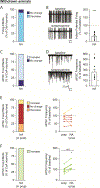The Amygdala Noradrenergic System Is Compromised With Alcohol Use Disorder
- PMID: 35430085
- PMCID: PMC9167785
- DOI: 10.1016/j.biopsych.2022.02.006
The Amygdala Noradrenergic System Is Compromised With Alcohol Use Disorder
Abstract
Background: Alcohol use disorder (AUD) is a leading preventable cause of death. The central amygdala (CeA) is a hub for stress and AUD, while dysfunction of the noradrenaline stress system is implicated in AUD relapse.
Methods: Here, we investigated whether alcohol (ethanol) dependence and protracted withdrawal alter noradrenergic regulation of the amygdala in rodents and humans. Male adult rats were housed under control conditions, subjected to chronic intermittent ethanol vapor exposure to induce dependence, or withdrawn from chronic intermittent ethanol vapor exposure for 2 weeks, and ex vivo electrophysiology, biochemistry (catecholamine quantification by high-performance liquid chromatography), in situ hybridization, and behavioral brain-site specific pharmacology studies were performed. We also used real-time quantitative polymerase chain reaction to assess gene expression of α1B, β1, and β2 adrenergic receptors in human postmortem brain tissue from men diagnosed with AUD and matched control subjects.
Results: We found that α1 receptors potentiate CeA GABAergic (gamma-aminobutyric acidergic) transmission and drive moderate alcohol intake in control rats. In dependent rats, β receptors disinhibit a subpopulation of CeA neurons, contributing to their excessive drinking. Withdrawal produces CeA functional recovery with no change in local noradrenaline tissue concentrations, although there are some long-lasting differences in the cellular patterns of adrenergic receptor messenger RNA expression. In addition, postmortem brain analyses reveal increased α1B receptor messenger RNA in the amygdala of humans with AUD.
Conclusions: CeA adrenergic receptors are key neural substrates of AUD. Identification of these novel mechanisms that drive alcohol drinking, particularly during the alcohol-dependent state, supports ongoing new medication development for AUD.
Keywords: Adrenergic receptor; Ethanol; Norepinephrine/noradrenaline; Prazosin; Propranolol; Translation.
Copyright © 2022 Society of Biological Psychiatry. Published by Elsevier Inc. All rights reserved.
Conflict of interest statement
Figures








References
Publication types
MeSH terms
Substances
Grants and funding
- R00 AA025393/AA/NIAAA NIH HHS/United States
- U01 AA013498/AA/NIAAA NIH HHS/United States
- F32 AA026765/AA/NIAAA NIH HHS/United States
- R01 AA028549/AA/NIAAA NIH HHS/United States
- T32 AA007456/AA/NIAAA NIH HHS/United States
- R01 AA017447/AA/NIAAA NIH HHS/United States
- R28 AA012725/AA/NIAAA NIH HHS/United States
- P60 AA006420/AA/NIAAA NIH HHS/United States
- R01 AA026999/AA/NIAAA NIH HHS/United States
- ZIA DA000635/ImNIH/Intramural NIH HHS/United States
- P50 AA006420/AA/NIAAA NIH HHS/United States
- K99 AA025393/AA/NIAAA NIH HHS/United States
- R01 AA027760/AA/NIAAA NIH HHS/United States
- R01 AA027700/AA/NIAAA NIH HHS/United States
- R00 AA025408/AA/NIAAA NIH HHS/United States
- R01 AA029841/AA/NIAAA NIH HHS/United States
- K01 AA023867/AA/NIAAA NIH HHS/United States
- R37 AA017447/AA/NIAAA NIH HHS/United States
- R01 AA015566/AA/NIAAA NIH HHS/United States
- R21 AA027614/AA/NIAAA NIH HHS/United States
- ZIA AA000218/ImNIH/Intramural NIH HHS/United States
- R01 AA021491/AA/NIAAA NIH HHS/United States
LinkOut - more resources
Full Text Sources
Medical

